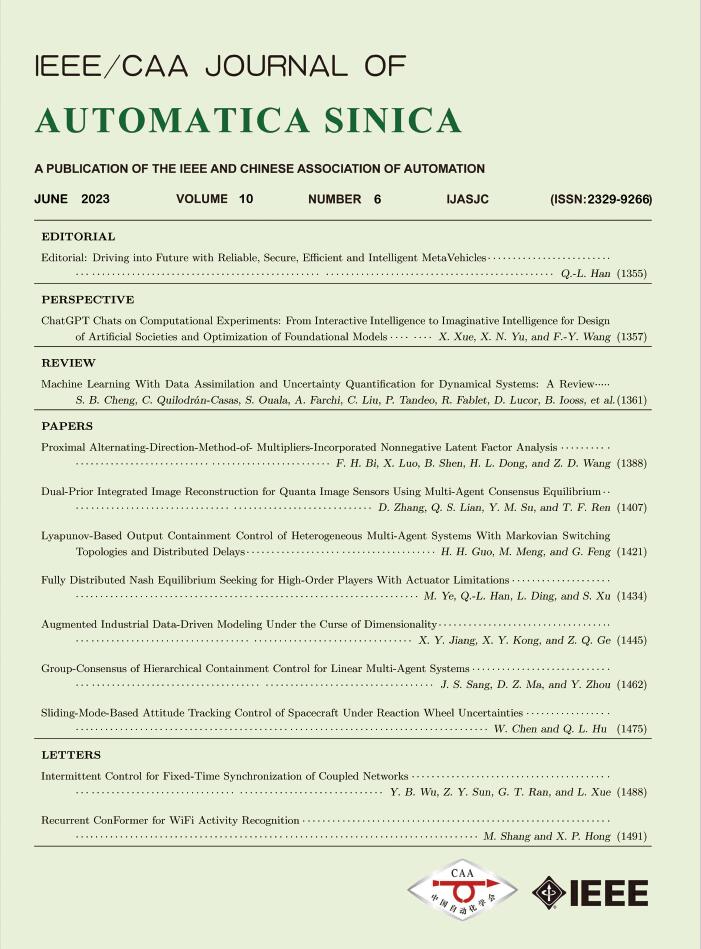 Volume 10
Issue 6
Volume 10
Issue 6
IEEE/CAA Journal of Automatica Sinica
| Citation: | X. Xue, X. N. Yu, and F.-Y. Wang, “ChatGPT chats on computational experiments: From interactive intelligence to imaginative intelligence for design of artificial societies and optimization of foundational models,” IEEE/CAA J. Autom. Sinica, vol. 10, no. 6, pp. 1357–1360, Jun. 2023. doi: 10.1109/JAS.2023.123585 |

| [1] |
F.-Y. Wang, “The emergence of intelligent enterprises: From CPS to CPSS,”IEEE Intelligent Systems, vol. 25, no. 4, pp. 85−88, 2010.
|
| [2] |
J. J. Zhang, F.-Y. Wang, X. Wang, et al., “Cyber-physical-social systems: The state of the art and perspectives,” IEEE Trans. Computational Social Syst., vol. 5, no. 3,pp. 829−840, 2018.
|
| [3] |
X. Xue, G. Li, D. Zhou, et al., “Research roadmap of service ecosystems: A crowd intelligence perspective,” Int. J. Crowd Science, vol. 6, no. 4, pp. 195−222, 2022.
|
| [4] |
X. Xue, Z. Chen, S. Wang, et al., “Value entropy: A systematic evaluation model of service ecosystem evolution”, IEEE Trans. Services Computing, vol. 15, no. 4, pp. 1760−1773,2022.
|
| [5] |
X. Xue, X. Yu, C. Peng, et al., “Computational experiments: Past, present and perpective,” ACTA Autom. Sinica, vol. 49, no. 2, pp. 246−271, 2023.
|
| [6] |
F.-Y. Wang, “Software-defined systems and knowledge automation: A parallel paradigm shift from Newton to Merton,” ACTA Autom. Sinica, vol. 41, no. 1, pp. 1−8, 2015.
|
| [7] |
F.-Y. Wang, “Parallel system approach and management and control of complex systems,” J. Control Decision, vol. 19, no. 5, pp. 485−489, 2004.
|
| [8] |
X. Xue, Computational Experiment Methods for Complex Systems: Principles, Models and Cases. Beijing, China: Science Press, 2020.
|
| [9] |
A. Radford, K. Narasimhan, T. Salimans, et al., “Improving language understanding by generative pre-training,” 2018. [Online], Available: https://cdn.openai.com/research-covers/language-unsupervised/language_understanding_paper.pdf.
|
| [10] |
F.-Y. Wang, Q. Miao, X. Li, et al., “What does ChatGPT say: The DAO from algorithmic intelligence to linguistic intelligence,” IEEE/CAA J. Autom. Sinica, vol. 10, no. 3, pp. 575−579, 2023.
|
| [11] |
R. Bommasani, D. A. Hudson, E. Adeli, et al. “On the opportunities and risks of foundation models,” arXiv preprint arXiv: 2108.07258, 2021.
|
| [12] |
L. Ouyang, J. Wu, X. Jiang, et al., “Training language models to follow instructions with human feedback,” arXiv preprint arXiv: 2203.02155, 2022.
|
| [13] |
J. Wei, Y. Tay, R. Bommasani, et al., “Emergent abilities of large language models,” arXiv preprint arXiv: 2206.07682, 2022.
|
| [14] |
J. Sohl-Dickstein, E. Weiss, N. Maheswaranathan, et al., “Deep unsupervised learning using nonequilibrium thermodynamics,” in Proc. Int. Conf. Machine Learning, 2015, pp. 2256−2265.
|
| [15] |
X. Xue, S. Wang, L. Zhang, et al., “Social learning evolution (SLE): Computational experiment-based modeling framework of social manufacturing,” IEEE Trans. Industrial Informatics, vol. 15, no. 6, pp. 3343−3355, 2018.
|
| [16] |
D. Zhou, X. Xue, and Z. Zhou, “SLE2: The improved social learning evolution model of cloud manufacturing service ecosystem,” IEEE Trans. Industrial Informatics, vol. 18, no. 12, pp. 9017−9026, 2022.
|
| [17] |
S. Wolfram, “Wolfram alpha as the way to bring computational knowledge superpowers to ChatGPT,” 2023. [Onlne]. Available: https://writings.Stephenwolfram.com/2023/01/wolframalpha-as-the-way-to-bring-computational-knowledge-superpowers-to-ChatGPT/.
|
| [18] |
L. Li, Y. Lin, N. Zheng, et al., “Parallel learning: A perspective and a framework,” IEEE/CAA J. Autom. Sinica, vol. 4, no. 3, pp. 389−395, 2017.
|
| [19] |
J. Pearl, D. Mackenzie. The Book of Why: The New Science of Cause and Effect. New York, USA: Basic Books, 2018.
|